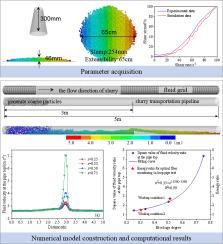Dynamic characteristics of gangue slurry flow in pipelines under blockage conditions: Numerical Simulations
IF 4.6
2区 工程技术
Q2 ENGINEERING, CHEMICAL
引用次数: 0
Abstract
Research on the dynamic characteristics of pipeline fluids under blockage conditions is critical for mitigating blockage-related risks. This study adopts the CFD-DEM coupling method, the movement processes of coarse particles during the pipeline transportation of gangue slurry are simulated and analyzed under varying degrees of pipeline blockage and grouting speeds. The influence laws of pipeline blockage degree and grouting speed on the dynamic characteristics of the slurry within the pipeline are explored. The findings indicate that: Upon completion of grouting, the maximum fluid resistance at the pipeline bottom at the blockage position increases linearly with the increase in blockage degree. The fluid gradient pressure and its variation both increase in a power exponential manner with the blockage degree. After grouting, the maximum fluid velocity and velocity variation at the pipeline top increase in a power exponential fashion with the blockage degree, and the fluid velocity ratio exhibits a power exponential growth trend. And the variation patterns of the fluid velocity peak position and velocity ratio at the pipeline top from numerical simulations, the pipeline blockage location and degree can be accurately determined. These research results offer a scientific foundation for enabling rapid and precise blockage location, thereby mitigating blockage risks.

堵塞条件下管道中脉石浆流动的动态特性:数值模拟
研究管道流体在堵塞条件下的动态特性对于降低堵塞风险至关重要。本研究采用CFD-DEM耦合方法,模拟分析了不同管道堵塞程度和注浆速度下矸石浆管道输送过程中粗颗粒的运动过程。探讨了管道堵塞程度和注浆速度对管道内浆体动力特性的影响规律。结果表明:注浆完成后,堵塞位置管道底部最大流体阻力随堵塞程度的增加呈线性增加;流体梯度压力及其变化均随堵塞程度呈幂指数增长。注浆后,管道最大流速和管道顶部流速变化随堵塞程度呈幂指数增长,流体流速比呈幂指数增长趋势。通过数值模拟得到管道顶部流体流速峰值位置和流速比的变化规律,可以准确地确定管道堵塞的位置和程度。这些研究成果为实现快速、精确的堵塞定位,从而降低堵塞风险提供了科学基础。
本文章由计算机程序翻译,如有差异,请以英文原文为准。
求助全文
约1分钟内获得全文
求助全文
来源期刊

Powder Technology
工程技术-工程:化工
CiteScore
9.90
自引率
15.40%
发文量
1047
审稿时长
46 days
期刊介绍:
Powder Technology is an International Journal on the Science and Technology of Wet and Dry Particulate Systems. Powder Technology publishes papers on all aspects of the formation of particles and their characterisation and on the study of systems containing particulate solids. No limitation is imposed on the size of the particles, which may range from nanometre scale, as in pigments or aerosols, to that of mined or quarried materials. The following list of topics is not intended to be comprehensive, but rather to indicate typical subjects which fall within the scope of the journal's interests:
Formation and synthesis of particles by precipitation and other methods.
Modification of particles by agglomeration, coating, comminution and attrition.
Characterisation of the size, shape, surface area, pore structure and strength of particles and agglomerates (including the origins and effects of inter particle forces).
Packing, failure, flow and permeability of assemblies of particles.
Particle-particle interactions and suspension rheology.
Handling and processing operations such as slurry flow, fluidization, pneumatic conveying.
Interactions between particles and their environment, including delivery of particulate products to the body.
Applications of particle technology in production of pharmaceuticals, chemicals, foods, pigments, structural, and functional materials and in environmental and energy related matters.
For materials-oriented contributions we are looking for articles revealing the effect of particle/powder characteristics (size, morphology and composition, in that order) on material performance or functionality and, ideally, comparison to any industrial standard.
 求助内容:
求助内容: 应助结果提醒方式:
应助结果提醒方式:


